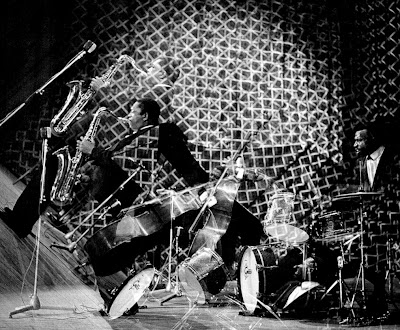John Coltrane was the master of modern jazz in the early sixties. He was a leader for angry young black musicians who wanted to re-appropriate their music from the dominant white culture. Against a background of the civil right movement, jazz musicians rejected the aesthetic criteria of mainstream American society and invented something new that would be called free jazz.
 |
| John Coltrane |
 |
| (L-R) John Coltrane, Cannonball Adderley, Miles Davis and Bill Evans; Kind Of Blue Recording Session |
With Giant Steps
In 1957, during a stint at the Five Spot in New York City with the Thelonious Monk Quartet, Coltrane was inspired by the unusual piano accompaniments. When Monk would leave the stage, Coltrane would take advantage of this time to explore new harmonic processes during long improvisations.
In 1958 Coltrane joined Miles Davis' new sextet, which recorded his masterpiece, Kind of Blue, a year later. Coltrane's playing had changed: from this point on he produced absolute torrents to sound. He brought his reflections on chord progressions to an end while recording 'Giant Steps', the ultimate outcome of the harmonic system of bebop, with his quartet. Thereafter he pursued his quest in the direction of modal jazz. In the meantime, even side by side with Miles Davis, he became increasingly alienated, and his long solo flights seemed to come from another universe.
 |
| Jimmy Garrison |
The Ascension
 |
| Artistic Retouched Photo of Coltrane's Dream Quartet |
After listening to various musicians, Coltrane put his dream quartet together 1961. With the solid double bassist Jimmy Garrison as pivotal figure, the drummer Elvin Jones developed a poly-rhythm that implied, rather than stated, the tempo; and into this tumultuous undertow McCoy Tyner's piano repeated tireless motifs that lured the soloist into a trance. Tyner's intentional harmonic uncertainties invited Coltrane to multiply the melodic phrases. One mode followed another, mixed, ground down, saturated with notes jostling each other until they overlapped, for a 'multiphonic' effect. Occasionally the tempo even disappeared altogether, diluted in long incantatory recitatives, such as the last section of love supreme.
More and more often, Coltrane preferred to omit the piano and double bass and remain alone with the energy flow transmitted by Elvin Jones.
 |
| Pharoah Sanders |
Some young members of the avant-garde of free jazz, who worshiped Coltrane, were invited to participate in the recording of the influential album Ascension,and one of them, Pharoah Sanders (tenor sax), began to play with him regularly after that. Soon Coltrane rid himself of McCoy Tyner's piano, which he had begun to see as standing in his way.
 |
| Rashied Ali and John Coltrane perform |
Elvin Jones left, too, in reaction to the arrival of the drummer Rashied Ali, whose conceptions of free jazz he did not share. Coltrane died on 17 July 1967, finally having attained the end of his quest for the upper limits of both fame and music. Throngs of musicians of every type remain haunted by the influence of his work to this day.
____________________

John, You gone too soon
ReplyDelete